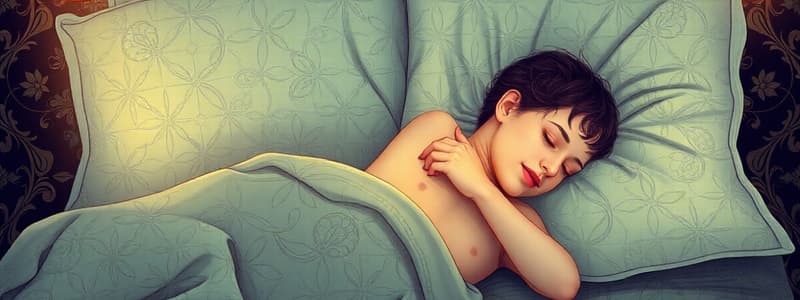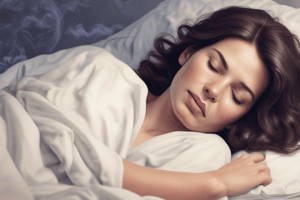Podcast
Questions and Answers
What is the primary cause of obstructive sleep apnoea?
What is the primary cause of obstructive sleep apnoea?
- Constriction of the trachea
- Overproduction of saliva during sleep
- Inflammation of the sinuses
- Collapse of the pharyngeal airway (correct)
Patients are typically aware of apnoea episodes during sleep.
Patients are typically aware of apnoea episodes during sleep.
False (B)
Name three established risk factors for obstructive sleep apnoea.
Name three established risk factors for obstructive sleep apnoea.
Middle age, male gender, obesity
Severe cases of obstructive sleep apnoea can lead to __________ and heart failure.
Severe cases of obstructive sleep apnoea can lead to __________ and heart failure.
Which of the following is a common presenting feature of obstructive sleep apnoea?
Which of the following is a common presenting feature of obstructive sleep apnoea?
The Epworth Sleepiness Scale is used to assess the severity of snoring.
The Epworth Sleepiness Scale is used to assess the severity of snoring.
What type of sleep study involves an overnight stay in a sleep centre with polysomnography?
What type of sleep study involves an overnight stay in a sleep centre with polysomnography?
__________ machines provide constant pressure to maintain airway patency in the management of obstructive sleep apnoea.
__________ machines provide constant pressure to maintain airway patency in the management of obstructive sleep apnoea.
What is the most common surgical procedure for obstructive sleep apnoea?
What is the most common surgical procedure for obstructive sleep apnoea?
Surgery is the first-line treatment for obstructive sleep apnoea.
Surgery is the first-line treatment for obstructive sleep apnoea.
Which of the following is NOT typically monitored during respiratory polygraphy?
Which of the following is NOT typically monitored during respiratory polygraphy?
A simple sleep study involves an overnight stay in a sleep centre.
A simple sleep study involves an overnight stay in a sleep centre.
Daytime __________ should raise suspicion for obstructive sleep apnoea, especially in professions requiring full alertness.
Daytime __________ should raise suspicion for obstructive sleep apnoea, especially in professions requiring full alertness.
Other than CPAP, name one potential method of managing Obstructive Sleep Apnoea.
Other than CPAP, name one potential method of managing Obstructive Sleep Apnoea.
A patient with suspected obstructive sleep apnea reports only snoring, with no other symptoms. Which action is most appropriate?
A patient with suspected obstructive sleep apnea reports only snoring, with no other symptoms. Which action is most appropriate?
Obstructive sleep apnoea primarily affects elderly individuals.
Obstructive sleep apnoea primarily affects elderly individuals.
Which cardiovascular condition is least likely to be exacerbated by severe, untreated obstructive sleep apnoea?
Which cardiovascular condition is least likely to be exacerbated by severe, untreated obstructive sleep apnoea?
In respiratory polygraphy, a __________ sensor is used to measure airflow rate.
In respiratory polygraphy, a __________ sensor is used to measure airflow rate.
List two potential complications of uvulopalatopharyngoplasty (UPPP) surgery for obstructive sleep apnea.
List two potential complications of uvulopalatopharyngoplasty (UPPP) surgery for obstructive sleep apnea.
Which aspect of sleep is LEAST directly assessed by polysomnography in the diagnosis of obstructive sleep apnoea?
Which aspect of sleep is LEAST directly assessed by polysomnography in the diagnosis of obstructive sleep apnoea?
Weight loss is unlikely to be an effective intervention to improve Obstructive Sleep Apnoea.
Weight loss is unlikely to be an effective intervention to improve Obstructive Sleep Apnoea.
What is the primary aim of Continuous Positive Airway Pressure (CPAP) therapy in managing obstructive sleep apnoea?
What is the primary aim of Continuous Positive Airway Pressure (CPAP) therapy in managing obstructive sleep apnoea?
Why are patients with jobs requiring constant alertness prioritised for sleep apnoea assessment and treatment?
Why are patients with jobs requiring constant alertness prioritised for sleep apnoea assessment and treatment?
During sleep studies, __________ rate is monitored to assess the frequency of breaths per minute.
During sleep studies, __________ rate is monitored to assess the frequency of breaths per minute.
Reduced oxygen saturation during sleep is the only indicator of obstructive sleep apnoea.
Reduced oxygen saturation during sleep is the only indicator of obstructive sleep apnoea.
Which diagnostic method provides the MOST comprehensive assessment of sleep architecture and associated physiological parameters?
Which diagnostic method provides the MOST comprehensive assessment of sleep architecture and associated physiological parameters?
Name one potential impact of untreated obstructive sleep apnea on cognitive function.
Name one potential impact of untreated obstructive sleep apnea on cognitive function.
An increase in __________ circumference is a risk factor for developing obstructive sleep apnoea.
An increase in __________ circumference is a risk factor for developing obstructive sleep apnoea.
Alcohol consumption before bed can improve sleep quality for individuals with obstructive sleep apnoea.
Alcohol consumption before bed can improve sleep quality for individuals with obstructive sleep apnoea.
Match each sleep study type with its description:
Match each sleep study type with its description:
Patients with OSA who are awaiting assessment for CPAP may need __________ work duties.
Patients with OSA who are awaiting assessment for CPAP may need __________ work duties.
What is the significance of monitoring brain activity (EEG) during a complex sleep study?
What is the significance of monitoring brain activity (EEG) during a complex sleep study?
Individuals who experience daytime sleepiness due to obstructive sleep apnoea are at no increased risk of accidents.
Individuals who experience daytime sleepiness due to obstructive sleep apnoea are at no increased risk of accidents.
A patient is diagnosed with mild obstructive sleep apnoea but is intolerant to CPAP therapy. What is the next most appropriate intervention?
A patient is diagnosed with mild obstructive sleep apnoea but is intolerant to CPAP therapy. What is the next most appropriate intervention?
All patients who snore have obstructive sleep apnoea.
All patients who snore have obstructive sleep apnoea.
During respiratory polygraphy, oxygen __________ levels are monitored to assess for hypoxemia.
During respiratory polygraphy, oxygen __________ levels are monitored to assess for hypoxemia.
Aside from the Epworth Sleepiness Scale, name one other tool or questionnaire used to assess sleep-related symptoms.
Aside from the Epworth Sleepiness Scale, name one other tool or questionnaire used to assess sleep-related symptoms.
Which of the following statements best explains why obstructive sleep apnea can lead to hypertension?
Which of the following statements best explains why obstructive sleep apnea can lead to hypertension?
Young, otherwise healthy individuals are immune to developing obstructive sleep apnoea.
Young, otherwise healthy individuals are immune to developing obstructive sleep apnoea.
An alternative treatment option for Obstructive Sleep Apnoea, particularly in patients with mild to moderate OSA, may include the use of an __________.
An alternative treatment option for Obstructive Sleep Apnoea, particularly in patients with mild to moderate OSA, may include the use of an __________.
Aside from lifestyle modifications and CPAP therapy, what is one surgical intervention that can be considered for treating obstructive sleep apnea when other treatments have failed?
Aside from lifestyle modifications and CPAP therapy, what is one surgical intervention that can be considered for treating obstructive sleep apnea when other treatments have failed?
Flashcards
Obstructive Sleep Apnoea
Obstructive Sleep Apnoea
Collapse of the pharyngeal airway during sleep, causing episodes of stopped breathing.
Apnoeas
Apnoeas
Episodes where the person stops breathing for a few minutes during sleep.
OSA Risk Factors
OSA Risk Factors
Middle age, male, obesity, alcohol, and smoking.
OSA Presentation
OSA Presentation
Signup and view all the flashcards
OSA Cardiovascular Complications
OSA Cardiovascular Complications
Signup and view all the flashcards
Epworth Sleepiness Scale
Epworth Sleepiness Scale
Signup and view all the flashcards
Simple Sleep Study
Simple Sleep Study
Signup and view all the flashcards
Respiratory Polygraphy
Respiratory Polygraphy
Signup and view all the flashcards
Complex Sleep Study
Complex Sleep Study
Signup and view all the flashcards
OSA Management - Reversible Factors
OSA Management - Reversible Factors
Signup and view all the flashcards
CPAP
CPAP
Signup and view all the flashcards
OSA Surgery
OSA Surgery
Signup and view all the flashcards
uvulopalatopharyngoplasty (UPPP)
uvulopalatopharyngoplasty (UPPP)
Signup and view all the flashcards
Study Notes
Obstructive Sleep Apnoea (OSA)
- OSA results from the collapse of the pharyngeal airway.
- Apnoeas are episodes where breathing stops for a few minutes.
- Patients are often unaware of apnoea episodes, which are usually reported by partners.
Risk Factors
- Middle age is a risk factor
- Being male is a risk factor.
- Obesity is a risk factor
- Alcohol consumption is a risk factor
- Smoking is a risk factor
Presentation
- Episodes of apnoea during sleep are a key presenting feature.
- Snoring is a common symptom.
- Morning headaches can occur.
- Waking up feeling unrefreshed is a typical complaint.
- Daytime sleepiness is a notable symptom.
- Concentration problems may arise.
- Reduced oxygen saturation during sleep is observed.
- Severe cases can lead to hypertension and heart failure.
- OSA increases the risk of myocardial infarction and stroke.
- Daytime sleepiness should raise suspicion for OSA, especially in professions requiring high alertness.
Epworth Sleepiness Scale
- The Epworth Sleepiness Scale assesses sleepiness symptoms related to OSA.
Sleep Studies
- Sleep studies are performed to confirm OSA diagnosis.
- These studies are conducted by ENT or sleep specialist services.
Types of Sleep Studies
- A simple sleep study involves overnight oxygen saturation monitoring at home.
- Respiratory polygraphy uses a device to monitor respiratory rate, flow rate, oxygen saturation, and heart rate, usually at home.
- Complex sleep studies involve an overnight stay in a sleep center with polysomnography.
- Polysomnography may include EEG, EMG, and ECG monitoring.
Management
- Addressing reversible risk factors is crucial.
- Reducing alcohol consumption is recommended.
- Smoking cessation is advised.
- Weight loss is beneficial.
- CPAP machines deliver constant pressure to maintain airway patency.
- Surgery is an option involving reconstruction of the soft palate and jaw.
- The most common surgical procedure is uvulopalatopharyngoplasty (UPPP).
Studying That Suits You
Use AI to generate personalized quizzes and flashcards to suit your learning preferences.





